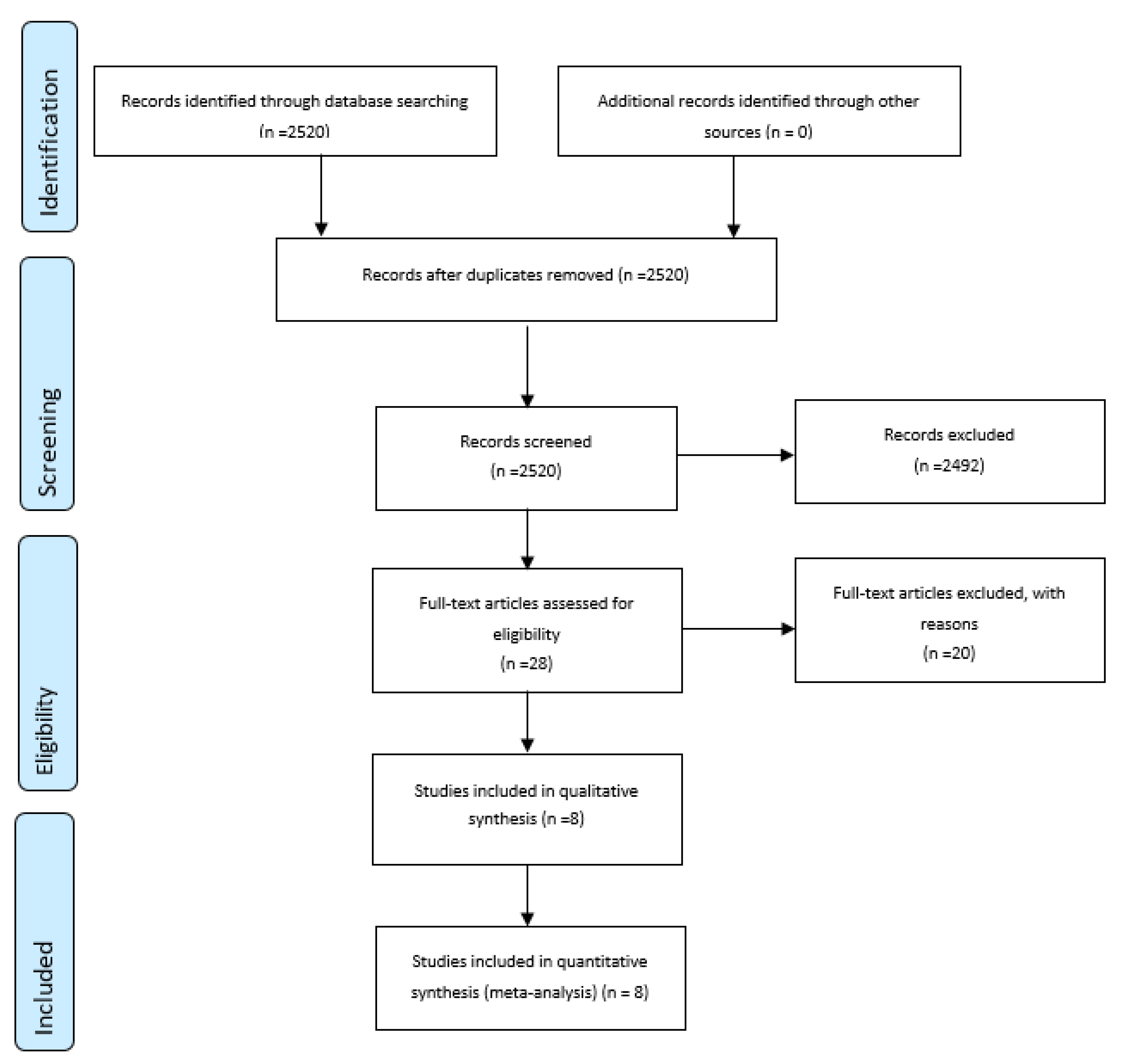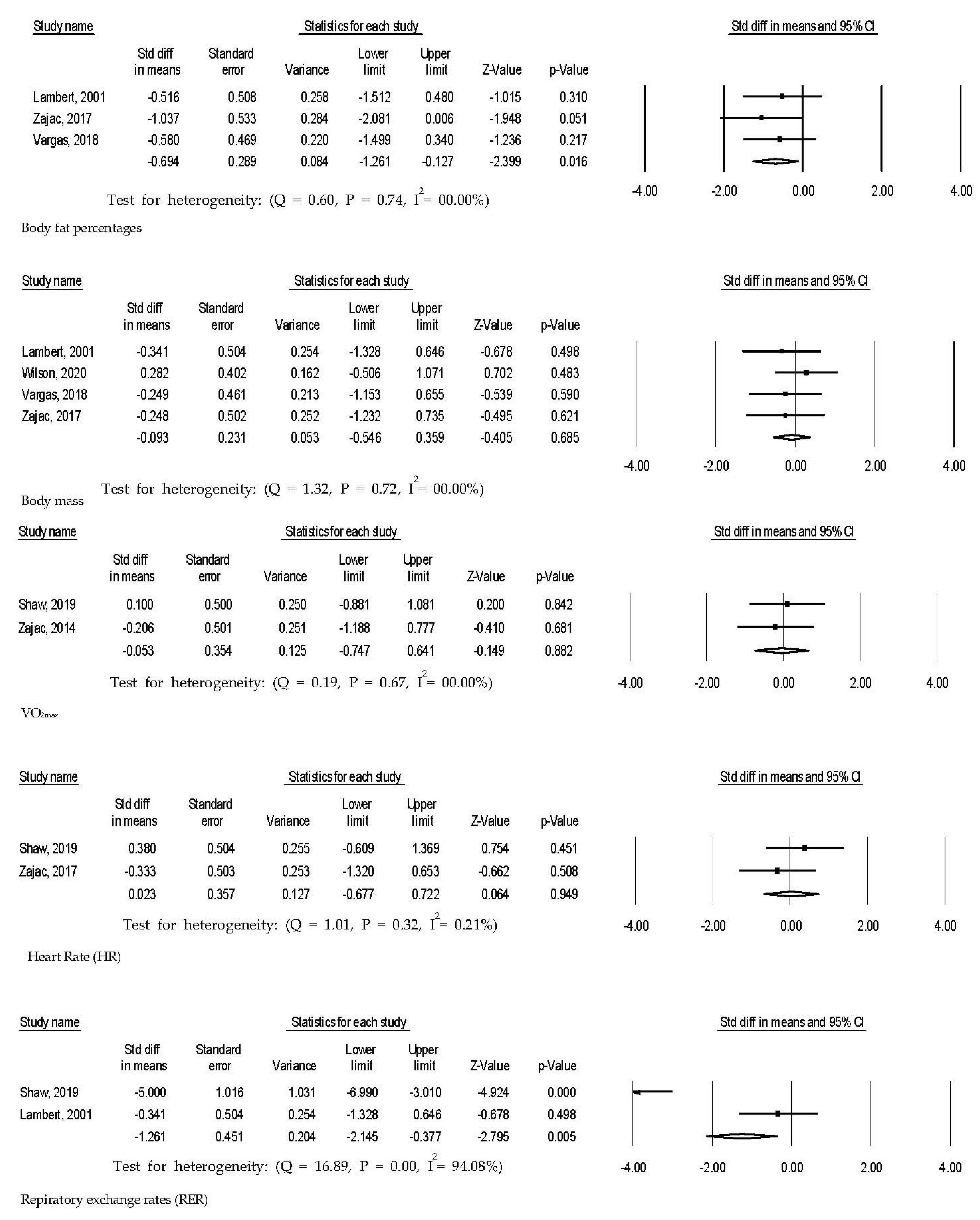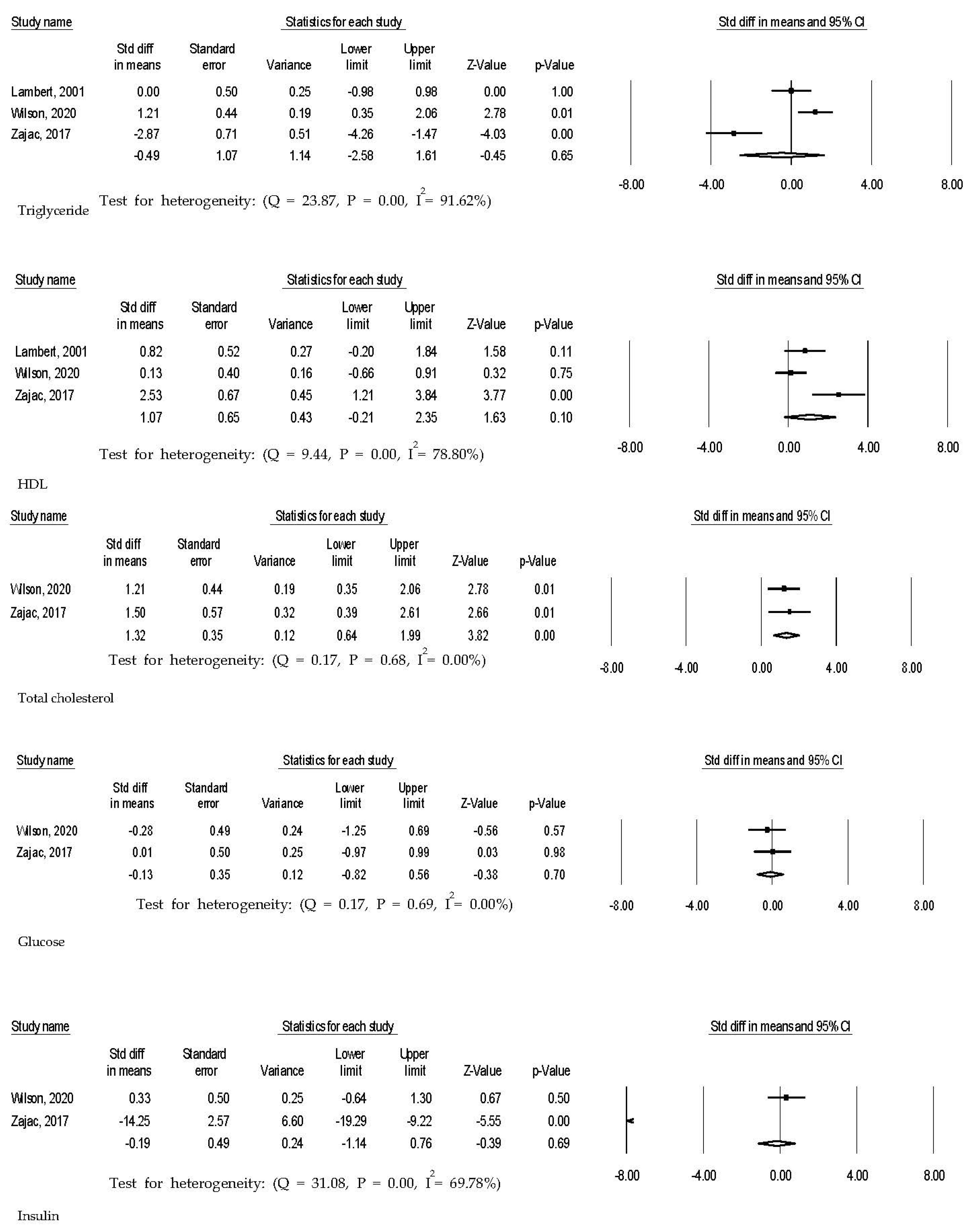Influences of Ketogenic Diet on Body Fat Percentage, Respiratory Exchange Rate, and Total Cholesterol in Athletes: A Systematic Review and Meta-Analysis
Abstract
1. Introduction
2. Materials and Methods
2.1. Searching Processes to Identify Eligible Studies
2.2. Statistical Analysis
3. Results
3.1. Influences of Ketogenic Diet on Body Composition
3.2. Influences of Ketogenic Diet on Respiratory Exchange Rate at VO2max, Cardiorespiratory Fitness, and Heart Rate
3.3. Influences of Ketogenic Diet on Total Cholesterol, HDL Cholesterol, Triglyceride, Glucose Level, and Insulin Level
4. Discussion
5. Conclusions
Supplementary Materials
Author Contributions
Funding
Institutional Review Board Statement
Informed Consent Statement
Conflicts of Interest
References
- Phinney, S.D.; Bistrian, B.R.; Evans, W.J.; Gervino, E.; Blackburn, G.L. The human metabolic response to chronic ketosis without caloric restriction: Preservation of submaximal exercise capability with reduced carbohydrate oxidation. Metabolism 1983, 32, 769–776. [Google Scholar] [CrossRef]
- Noakes, T.; Volek, J.S.; Phinney, S.D. Low-carbohydrate diets for athletes: What evidence? Br. J. Sports Med. 2014, 48, 1077–1078. [Google Scholar] [CrossRef]
- Rhyu, H.S.; Cho, S.Y. The effect of weight loss by ketogenic diet on the body composition, performance-related physical fitness factors and cytokines of Taekwondo athletes. J. Exerc. Rehabil. 2014, 10, 326–331. [Google Scholar] [CrossRef]
- Paoli, A.; Bianco, A.; Grimaldi, K.A. The Ketogenic Diet and Sport: A Possible Marriage? Exerc. Sport Sci. Rev. 2015, 43, 153–162. [Google Scholar] [CrossRef]
- McSwiney, F.T.; Doyle, L.; Plews, D.J.; Zinn, C. Impact Of Ketogenic Diet On Athletes: Current Insights. Open Access J. Sports Med. 2019, 10, 171–183. [Google Scholar] [CrossRef]
- Durkalec-Michalski, K.; Nowaczyk, P.M.; Siedzik, K. Effect of a four-week ketogenic diet on exercise metabolism in CrossFit-trained athletes. J. Int. Soc. Sports Nutr. 2019, 16, 16. [Google Scholar] [CrossRef] [PubMed]
- Kiens, B.; Helge, J.W. Effect of high-fat diets on exercise performance. Proc. Nutr. Soc. 1998, 57, 73–75. [Google Scholar] [CrossRef] [PubMed]
- Micha, R.; Mozaffarian, D. Saturated fat and cardiometabolic risk factors, coronary heart disease, stroke, and diabetes: A fresh look at the evidence. Lipids 2010, 45, 893–905. [Google Scholar] [CrossRef]
- Volek, J.S.; Freidenreich, D.J.; Saenz, C.; Kunces, L.J.; Creighton, B.C.; Bartley, J.M.; Davitt, P.M.; Munoz, C.X.; Anderson, J.M.; Maresh, C.M.; et al. Metabolic characteristics of keto-adapted ultra-endurance runners. Metabolism 2016, 65, 100–110. [Google Scholar] [CrossRef]
- Higgins, J.P.; Altman, D.G.; Gotzsche, P.C.; Juni, P.; Moher, D.; Oxman, A.D.; Savovic, J.; Schulz, K.F.; Weeks, L.; Sterne, J.A.; et al. The Cochrane Collaboration’s tool for assessing risk of bias in randomised trials. BMJ 2011, 343, d5928. [Google Scholar] [CrossRef] [PubMed]
- Shaw, D.M.; Merien, F.; Braakhuis, A.; Maunder, E.D.; Dulson, D.K. Effect of a Ketogenic Diet on Submaximal Exercise Capacity and Efficiency in Runners. Med. Sci. Sports Exerc. 2019, 51, 2135–2146. [Google Scholar] [CrossRef] [PubMed]
- Burke, L.M.; Ross, M.L.; Garvican-Lewis, L.A.; Welvaert, M.; Heikura, I.A.; Forbes, S.G.; Mirtschin, J.G.; Cato, L.E.; Strobel, N.; Sharma, A.P.; et al. Low carbohydrate, high fat diet impairs exercise economy and negates the performance benefit from intensified training in elite race walkers. J. Physiol. 2017, 595, 2785–2807. [Google Scholar] [CrossRef] [PubMed]
- Goedecke, J.H.; Elmer-English, R.; Dennis, S.C.; Schloss, I.; Noakes, T.D.; Lambert, E.V. Effects of medium-chain triaclyglycerol ingested with carbohydrate on metabolism and exercise performance. Int. J. Sport Nutr. 1999, 9, 35–47. [Google Scholar] [CrossRef]
- Greene, D.A.; Varley, B.J.; Hartwig, T.B.; Chapman, P.; Rigney, M. A Low-Carbohydrate Ketogenic Diet Reduces Body Mass Without Compromising Performance in Powerlifting and Olympic Weightlifting Athletes. J. Strength Cond. Res. 2018, 32, 3373–3382. [Google Scholar] [CrossRef]
- Lambert, E.V.; Goedecke, J.H.; Zyle, C.; Murphy, K.; Hawley, J.A.; Dennis, S.C.; Noakes, T.D. High-fat diet versus habitual diet prior to carbohydrate loading: Effects of exercise metabolism and cycling performance. Int. J. Sport Nutr. Exerc. Metab. 2001, 11, 209–225. [Google Scholar] [CrossRef] [PubMed]
- Vargas, S.; Romance, R.; Petro, J.L.; Bonilla, D.A.; Galancho, I.; Espinar, S.; Kreider, R.B.; Benitez-Porres, J. Efficacy of ketogenic diet on body composition during resistance training in trained men: A randomized controlled trial. J. Int. Soc. Sports Nutr. 2018, 15, 31. [Google Scholar] [CrossRef]
- Wilson, J.M.; Lowery, R.P.; Roberts, M.D.; Sharp, M.H.; Joy, J.M.; Shields, K.A.; Partl, J.M.; Volek, J.S.; D’Agostino, D.P. Effects of Ketogenic Dieting on Body Composition, Strength, Power, and Hormonal Profiles in Resistance Training Men. J. Strength Cond Res. 2020, 34, 3463–3474. [Google Scholar] [CrossRef] [PubMed]
- Zajac, A.; Poprzecki, S.; Maszczyk, A.; Czuba, M.; Michalczyk, M.; Zydek, G. The effects of a ketogenic diet on exercise metabolism and physical performance in off-road cyclists. Nutrients 2014, 6, 2493–2508. [Google Scholar] [CrossRef]
- Zinn, C.; Wood, M.; Williden, M.; Chatterton, S.; Maunder, E. Ketogenic diet benefits body composition and well-being but not performance in a pilot case study of New Zealand endurance athletes. J. Int. Soc. Sports Nutr. 2017, 14, 22. [Google Scholar] [CrossRef]
- Shete, A.N.; Bute, S.S.; Deshmukh, P.R. A Study of VO2 Max and Body Fat Percentage in Female Athletes. J. Clin. Diagn. Res. 2014, 8, BC01–BC03. [Google Scholar] [CrossRef]
- McSwiney, F.T.; Fusco, B.; McCabe, L.; Lombard, A.; Crowley, P.; Walsh, J.; Hone, M.; Egan, B. Changes in body composition and substrate utilization after a short-term ketogenic diet in eundurance-trained males. Biol. Sport 2021, 38, 145–152. [Google Scholar] [CrossRef]
- Lambert, E.V.; Wooding, G.; Lambert, M.I.; Koeslag, J.H.; Noakes, T.D. Enhanced adipose tissue lipoprotein lipase activity in detrained rats: Independent of changes in food intake. J. Appl. Physiol. 1994, 77, 2564–2571. [Google Scholar] [CrossRef] [PubMed]
- Stellingwerff, T.; Spriet, L.L.; Watt, M.J.; Kimber, N.E.; Hargreaves, M.; Hawley, J.A.; Burke, L.M. Decreased PDH activation and glycogenolysis during exercise following fat adaptation with carbohydrate restoration. Am. J. Physiol. Endocrinol. Metab. 2006, 290, E380–E388. [Google Scholar] [CrossRef] [PubMed]
- Havemann, L.; West, S.J.; Goedecke, J.H.; Macdonald, I.A.; St Clair Gibson, A.; Noakes, T.D.; Lambert, E.V. Fat adaptation followed by carbohydrate loading compromises high-intensity sprint performance. J. Appl. Physiol. 2006, 100, 194–202. [Google Scholar] [CrossRef]
- Halldin, A.K.; Lissner, L.; Lernfelt, B.; Bjorkelund, C. Cholesterol and triglyceride levels in midlife and risk of heart failure in women, a longitudinal study: The prospective population study of women in Gothenburg. BMJ Open 2020, 10, e036709. [Google Scholar] [CrossRef] [PubMed]
- Canoui-Poitrine, F.; Luc, G.; Bard, J.M.; Ferrieres, J.; Yarnell, J.; Arveiler, D.; Morange, P.; Kee, F.; Evans, A.; Amouyel, P.; et al. Relative contribution of lipids and apolipoproteins to incident coronary heart disease and ischemic stroke: The PRIME Study. Cerebrovasc. Dis. 2010, 30, 252–259. [Google Scholar] [CrossRef]
- Petridou, A.; Lazaridou, D.; Mougios, V. Lipidemic profile of athletes and non-athletes with similar body fat. Int. J. Sport Nutr. Exerc. Metab. 2005, 15, 425–432. [Google Scholar] [CrossRef] [PubMed]
- Marques, E.; Carvalho, J.; Soares, J.M.; Marques, F.; Mota, J. Effects of resistance and multicomponent exercise on lipid profiles of older women. Maturitas 2009, 63, 84–88. [Google Scholar] [CrossRef]
- Gordon, L.A.; Morrison, E.Y.; McGrowder, D.A.; Young, R.; Fraser, Y.T.; Zamora, E.M.; Alexander-Lindo, R.L.; Irving, R.R. Effect of exercise therapy on lipid profile and oxidative stress indicators in patients with type 2 diabetes. BMC Complement Altern Med. 2008, 8, 21. [Google Scholar] [CrossRef]
- Kephart, W.C.; Pledge, C.D.; Roberson, P.A.; Mumford, P.W.; Romero, M.A.; Mobley, C.B.; Martin, J.S.; Young, K.C.; Lowery, R.P.; Wilson, J.M.; et al. The Three-Month Effects of a Ketogenic Diet on Body Composition, Blood Parameters, and Performance Metrics in CrossFit Trainees: A Pilot Study. Sports 2018, 6, 1. [Google Scholar] [CrossRef]
- Kinzig, K.P.; Honors, M.A.; Hargrave, S.L. Insulin sensitivity and glucose tolerance are altered by maintenance on a ketogenic diet. Endocrinology 2010, 151, 3105–3114. [Google Scholar] [CrossRef] [PubMed]
- Helge, J.W.; Richter, E.A.; Kiens, B. Interaction of training and diet on metabolism and endurance during exercise in man. J. Physiol. 1996, 492 Pt 1, 293–306. [Google Scholar] [CrossRef]
- Bergstrom, J.; Hermansen, L.; Hultman, E.; Saltin, B. Diet, muscle glycogen and physical performance. Acta Physiol. Scand. 1967, 71, 140–150. [Google Scholar] [CrossRef]
- Jansson, E.; Kaijser, L. Effect of diet on muscle glycogen and blood glucose utilization during a short-term exercise in man. Acta Physiol. Scand. 1982, 115, 341–347. [Google Scholar] [CrossRef] [PubMed]



| First Author (Year), Country | Design, Number of Participants per Group, Age (Years Old) | Participants/Control | Exercise Intervention | Ketogenic Diet including Length, Energy, and Compositions/Contorl Group/Assessments of Ketosis | Outcomes |
|---|---|---|---|---|---|
| Aerobic exercise | |||||
| Goedecke, (1999), South Africa [13] | Randomized controlled trails: high fat diet (HFD, n = 8, 24 ± 3 years old) vs. control (CON, n = 8, 30 ± 9 years old) | Endurance-trained male cyclists | 4 weeks, high intensity interval training 10 × 60 s cycling intervals & 60 s of recovery, 3 days/week | 15 days, no restricted calories, HFD: total energy (4334 ± 3382 kJ), fat (32 ± 8%), carbohydrate (48 ± 10%), protein (14 ± 2%), control: 13,210 ± 3382 kJ, fat (30 ± 8%), carbohydrate (53 ± 10%), protein (13 ± 3%), blood samples | Glucose, lactate, insulin, free fat oxidation, β-hydroxybutyrate, plasma glucose oxidation, ingested glucose oxidation, muscle glycogen oxidation, carnitine acyltransferase (CAD), 3-hydrozyacyl-coenzyme a dehydrogenase (3-HAD), citrate synthase (CS), glucose transport-4 (GLUT-4) |
| Lambert (2001), United Kingdom [15] | Randomized cross over trails: high fat (HF, n = 8) vs. control (n = 8), average 22.4 ± 1.5 year old | Endurance-trained male cyclists | 4 weeks, high intensity interval training 10 × 60 s cycling intervals & 60 s of recovery, 3 days/week | 14 days, high fat (energy 14.00 MJ, carbohydrate: <15%, protein: 20%, fat: >65%), habitual diet (energy 14.3 ± 0.7 MJ, carbohydrate: 52.6 ± 5.8, protein: 12.8 ± 0.9, fat: 29.9 ± 4.5), ß-hydroxybutyrate ketone level | Weight, body fat, serum cholesterol, serum high density lipoprotein (HDL) cholesterol, serum triglyceride |
| Zajac, (2014), Australia [18] | Randomized cross over trails: exercise + low carbohydrate diet (n = 8, 25.4 ± 4.0 years old) vs. control (n = 8, 25 ± 7 years old) | Cyclists, body fat | 6 months, ≥30 min/day, ≥5 days/week | 6 months, 2200 kcal/day, isocaloric diets in keteogenic diet and standard Western diet, ketogeic diet (70% fat, 15% protein, 15% carbohydrates), mixed or standard Western diet (50% carbohydrates, 30% fat, 20% protein), 30 ß-hydroxybutyrate ketone level | Carbohydrates, fat, protein, calories, weight, Body mass index, HOMA, glucose, insulin, HbA1c, cholesterol, low density lipoprotein (LDL) cholesterol, HDL cholesterol, triglycerides, prostate-specific antigen, HsCRP, heart rate, VO2max, respiratory exchange rate (RER) |
| Burke (2017), Australia [12] | Randomized controlled trails: high carbohydrate diet (HCD, n = 9, 25.4 ± 4.0 years old), periodised carbohydrate (PCHOD, n = 10, 27.4 ± 4.6 years old) low carbohydrate high fat diet (LCHFD, n = 10, 28.3 ± 3.5 year old) | Elite race walkers | 4 days, ~30 min walking after breakfast, lunch, and dinner, ~60% of maximal heart rate, accelerometer | 3 weeks, HC: daliy energy intake: 14.73 MJ 231 kJ/kg (carbohydrate: 549 g, 8.6 g/kg, 60% energy, protein:138 g, 2.1 g/kg, 16% energy, fat: 77 g, 1.2 g/kg, 20% energy), PCHO: daliy energy intake: 14.89 MJ 226 kJ/kg (fat: 79 g, 1.2 g/kg, 20%, protein: 144 g, 2.2 g/kg, 17% energy, carbohydrate:547g, 8.3 g/kg, 60% enegry), LCHF: daliy energy intake: 14.90 MJ 223 kJ/kg (fat: 312 g, 4.7 g/kg, 78% energy, protein: 144 g, 2.2 g/kg, 17% energy, carbohydrate:33g, 0.5g/kg, 3.5% enegry), ß-hydroxybutyrate ketone level | Body mass, respiratory exchange ratio, VO2max, heart rate, perceived exertion (RPE) |
| Resistance exercise | |||||
| Wilson (2017), U.S.A. [17] | Randomized controlled trails: exercise + ketogenic diet (n = 13, 23.5 ± 4.5 years old), vs. exercise + regular diet (n = 12, 21.3 ± 3.7 years old) | Resistance training men | 11 weeks, resistance exercise (week 1: 65% and 15 repetitions, 85% and 5 repetitions, week 2: 70% and 12 repetitions, 90% and 4 repetitions, week 3: 75% and 10 repetitions, 90% and 3 repetitions week 4: 77.5% and 8 repetitions, 90–100% and 1–2 repetitions, week 3–6 hypertrophy, week 7–10: strength, squat, lunges, leg extension, leg curl, bench, stiff leg deadlift, hyperextension, leg press, calf press) | 10~11 weeks, ketogenic diet: 2652.9 ± 205.6 kcal/day, 75% fat, 20% protein, 5% carbohydrate, until blood ketone bodies detected, regular diet: 2528.1 ± 200.4 kcal/day, 20% protein, 5% carbohydrate, 75% fat | Total mass, muscle thickness, bench press, squat, Wingate power, testosterone total, testosterone free, inclusion blood glucose, triglycerides, total cholesterol, high density lipoprotein |
| Greene (2018), Australia [14] | Randomized cross over trails: low carbohydrate ketogenic diet (n = 12), vs. usual diet (n = 12), average 35 ± 5 years old | Elite powerlifters and Olympic weight lifters | 4 weeks, high intensity interval training (10 × 6 s cycling sprints & 9 s recovery, total 2.5 min/session), moderate intensity continuous training (30 min cycling, 5 min for warm-up, 50% of VO2peak for 10 min, 60% of VO2peask for 10 min, 5 min for recovery), 5 days/week, pedometers, logbook | 12 weeks, low carbohydrate ketogenic diet: usal diet diet: [male (energy intake: 9868.1 ± 1322.9 kJ/day, carbohydrate: 7.5 ± 2.1%, fat: 70.1 ± 6.6%, protein: 22.4 ± 5.7%, female (energy intake: 6995.5 ± 1554.5 kJ/day, carbohydrate: 8.9 ± 1.7%, fat: 67.6 ± 4.1%, protein: 23.5 ± 2.9%, usal diet diet: [male (energy intake: 9653.2 ± 1885.4 kJ/day, carbohydrate: 44.7 ± 2.8%, fat: 33.7 ± 6.2%, protein: 21.7 ± 6.5%, female (energy intake: 7147.5 ± 1500 kJ/day, carbohydrate: 45.1 ± 7.1%, fat: 32.4 ± 6.3%, protein: 22.5 ± 5.8%, ß-hydroxybutyrate ketone level | Body mass, fat mass, lean mass, 1 repetition maximum (1RM), resting metabolic rate (RMR), respiratory quotient, glucose, potassium, sodium |
| Vargas (2018), Spain [16] | Randomized controlled trails: exercise + ketogenic diet (n = 9), non-ketogenic diet (n = 10) vs. control (n = 5), average 30 ± 4.7 years old | Trained men | 8 weeks, hypertrophy training (upper limb and lower limb 2 times per week) | 8 weeks, a daily energy intake ≥39 kcal/kg/day, ketogenic diet: 70% fat, 20% protein, <10% carbohydrate, and until blood ketone were monitored weekly, non-ketogenic diet: 55% carbohydrat, 20% fat, 20% protein | Body weight, fat mass, visceral adipose tissue, lean body mass |
| Shaw (2019), New Zealand, [11] | Randomized repeated-measure crossover study, CT: exercise + ketogenic diet (n = 8), average 29.6 ± 5.1 uears old | Trained male endurance athletes | 28 days, running and cycling training | 28 days, ketogenic diet: [male (energy intake: 13.73 ± 2.43 MJ/day, carbohydrate: 4.1 ± 0.8%, fat: 77.7 ± 3.9%, protein: 18.2 ± 3.5%, usal diet diet: [male (energy intake: 13.07 ± 1.67 MJ/day, carbohydrate: 42.9 ± 7.8%, fat: 38.5 ± 7.1%, protein: 18.6 ± 1.45%, ß-hydroxybutyrate ketone level | Body mass, VO2max (L∙min−1), respiratory exchange ratio, energy expenditure, heart rate, rate of perceived exertion |
Publisher’s Note: MDPI stays neutral with regard to jurisdictional claims in published maps and institutional affiliations. |
© 2021 by the authors. Licensee MDPI, Basel, Switzerland. This article is an open access article distributed under the terms and conditions of the Creative Commons Attribution (CC BY) license (http://creativecommons.org/licenses/by/4.0/).
Share and Cite
Lee, H.S.; Lee, J. Influences of Ketogenic Diet on Body Fat Percentage, Respiratory Exchange Rate, and Total Cholesterol in Athletes: A Systematic Review and Meta-Analysis. Int. J. Environ. Res. Public Health 2021, 18, 2912. https://doi.org/10.3390/ijerph18062912
Lee HS, Lee J. Influences of Ketogenic Diet on Body Fat Percentage, Respiratory Exchange Rate, and Total Cholesterol in Athletes: A Systematic Review and Meta-Analysis. International Journal of Environmental Research and Public Health. 2021; 18(6):2912. https://doi.org/10.3390/ijerph18062912
Chicago/Turabian StyleLee, Hyun Suk, and Junga Lee. 2021. "Influences of Ketogenic Diet on Body Fat Percentage, Respiratory Exchange Rate, and Total Cholesterol in Athletes: A Systematic Review and Meta-Analysis" International Journal of Environmental Research and Public Health 18, no. 6: 2912. https://doi.org/10.3390/ijerph18062912
APA StyleLee, H. S., & Lee, J. (2021). Influences of Ketogenic Diet on Body Fat Percentage, Respiratory Exchange Rate, and Total Cholesterol in Athletes: A Systematic Review and Meta-Analysis. International Journal of Environmental Research and Public Health, 18(6), 2912. https://doi.org/10.3390/ijerph18062912







